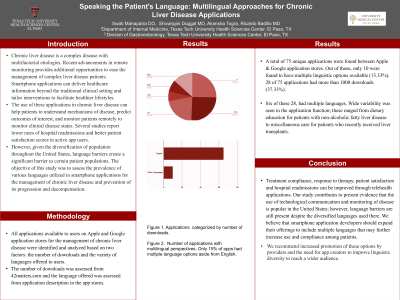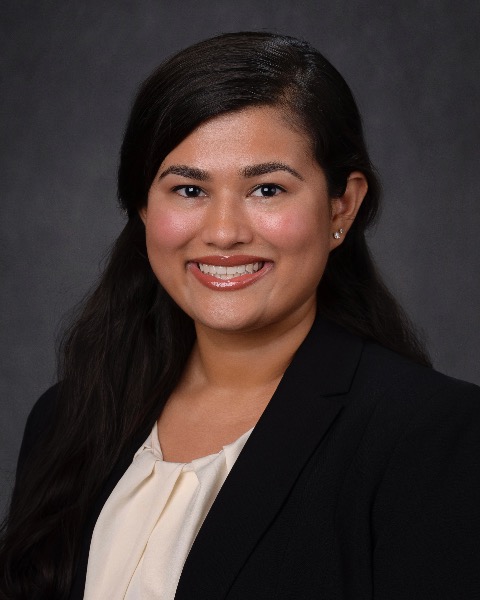Sunday Poster Session
Category: Liver
P1224 - Speaking the Patient's Language: Multilingual Approaches for Chronic Liver Disease Applications
Sunday, October 27, 2024
3:30 PM - 7:00 PM ET
Location: Exhibit Hall E

Has Audio

Swati Mahapatra, DO
TTUHSC
El Paso, TX
Presenting Author(s)
Swati Mahapatra, DO1, Shivangini Duggal, MD1, Akanksha Togra, MD2, Ricardo Badillo, MD1
1TTUHSC, El Paso, TX; 2Texas Tech University Health Sciences Center, El Paso, TX
Introduction: Chronic liver disease is a complex disease with multifactorial etiologies. Recent advancements in remote monitoring provides additional opportunities to ease the management of complex liver disease patients. Smartphone applications can deliver healthcare information beyond the traditional clinical setting and tailor interventions to facilitate healthier lifestyles. The use of these applications in chronic liver disease can help patients to understand mechanisms of disease, predict outcomes of interest, and monitor patients remotely to monitor clinical disease states. Several studies report lower rates of hospital readmissions and better patient satisfaction scores in active app users. However, given the diversification of population throughout the United States, language barriers create a significant barrier to certain patient populations. The objective of this study was to assess the prevalence of various languages utilized in smartphone applications for the management of chronic liver disease and prevention of its progression and decompensation.
Methods: All applications available to users on Apple and Google application stores for the management of chronic liver disease were identified and analyzed based on two factors: the number of downloads and the variety of languages offered to users. The number of downloads was assessed from 42matters.com and the language offered was assessed from application description in the app stores.
Results: A total of 75 unique applications were found between Apple & Google application stores. Out of those, only 10 were found to have multiple linguistic options available (13.33%). 28 of 75 applications had more than 1000 downloads (37.33%). Six of these 28, had multiple languages. Wide variability was seen in the application function; these ranged from dietary education for patients with non-alcoholic fatty liver disease to miscellaneous care for patients who recently received liver transplants.
Discussion: Treatment compliance, response to therapy, patient satisfaction and hospital readmissions can be improved through telehealth applications. Our study contributes to present evidence that the use of technological communication and monitoring of disease is popular in the United States; however, language barriers are still present despite the diversified languages used there. We believe that smartphone application developers should expand their offerings to include multiple languages that may further increase use and compliance among patients.
Disclosures:
Swati Mahapatra, DO1, Shivangini Duggal, MD1, Akanksha Togra, MD2, Ricardo Badillo, MD1. P1224 - Speaking the Patient's Language: Multilingual Approaches for Chronic Liver Disease Applications, ACG 2024 Annual Scientific Meeting Abstracts. Philadelphia, PA: American College of Gastroenterology.
1TTUHSC, El Paso, TX; 2Texas Tech University Health Sciences Center, El Paso, TX
Introduction: Chronic liver disease is a complex disease with multifactorial etiologies. Recent advancements in remote monitoring provides additional opportunities to ease the management of complex liver disease patients. Smartphone applications can deliver healthcare information beyond the traditional clinical setting and tailor interventions to facilitate healthier lifestyles. The use of these applications in chronic liver disease can help patients to understand mechanisms of disease, predict outcomes of interest, and monitor patients remotely to monitor clinical disease states. Several studies report lower rates of hospital readmissions and better patient satisfaction scores in active app users. However, given the diversification of population throughout the United States, language barriers create a significant barrier to certain patient populations. The objective of this study was to assess the prevalence of various languages utilized in smartphone applications for the management of chronic liver disease and prevention of its progression and decompensation.
Methods: All applications available to users on Apple and Google application stores for the management of chronic liver disease were identified and analyzed based on two factors: the number of downloads and the variety of languages offered to users. The number of downloads was assessed from 42matters.com and the language offered was assessed from application description in the app stores.
Results: A total of 75 unique applications were found between Apple & Google application stores. Out of those, only 10 were found to have multiple linguistic options available (13.33%). 28 of 75 applications had more than 1000 downloads (37.33%). Six of these 28, had multiple languages. Wide variability was seen in the application function; these ranged from dietary education for patients with non-alcoholic fatty liver disease to miscellaneous care for patients who recently received liver transplants.
Discussion: Treatment compliance, response to therapy, patient satisfaction and hospital readmissions can be improved through telehealth applications. Our study contributes to present evidence that the use of technological communication and monitoring of disease is popular in the United States; however, language barriers are still present despite the diversified languages used there. We believe that smartphone application developers should expand their offerings to include multiple languages that may further increase use and compliance among patients.
Disclosures:
Swati Mahapatra indicated no relevant financial relationships.
Shivangini Duggal indicated no relevant financial relationships.
Akanksha Togra: Clinexel Inc – Owner/Ownership Interest. Clinexel Life Sciences Pvt Ltd – Owner/Ownership Interest. Cytenet Life science LLP – Owner/Ownership Interest. GLRK Healthcare foundation (Non-profit Organization Company) – Owner/Ownership Interest.
Ricardo Badillo indicated no relevant financial relationships.
Swati Mahapatra, DO1, Shivangini Duggal, MD1, Akanksha Togra, MD2, Ricardo Badillo, MD1. P1224 - Speaking the Patient's Language: Multilingual Approaches for Chronic Liver Disease Applications, ACG 2024 Annual Scientific Meeting Abstracts. Philadelphia, PA: American College of Gastroenterology.
